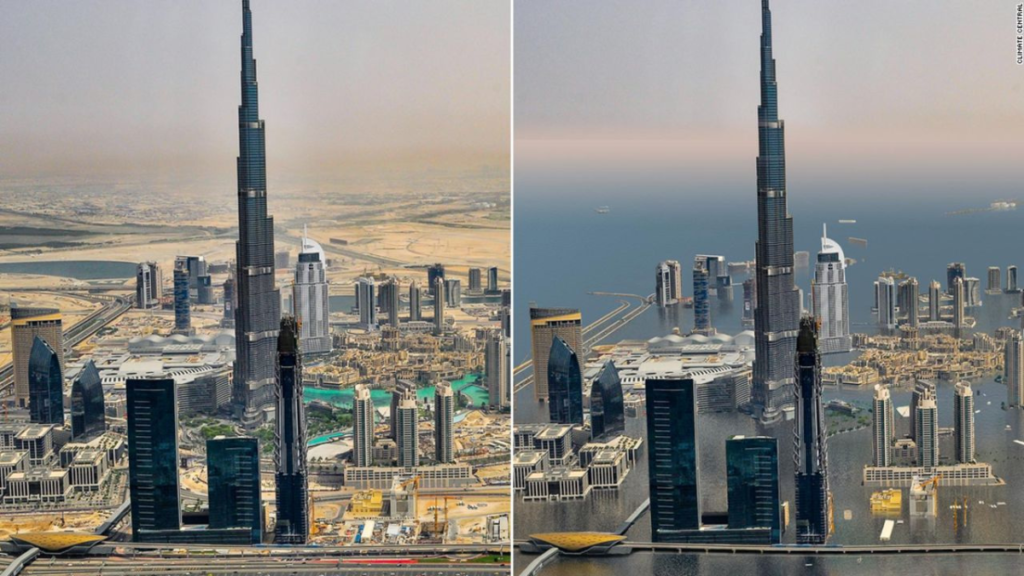Climate Central’s analysis of rising sea levels at the UN climate summit in Dubai highlights the potential consequences of climate change, including droughts, floods, and glacier melting. The report highlights the importance of decisive action as global temperatures are projected to rise by up to 2.9 degrees Celsius. The analysis uses peer-reviewed sea level rise projections and local elevation data to illustrate the risk of inundation or submersion under different warming scenarios. Climate Central’s chief scientist and CEO, Benjamin Strauss, emphasizes the pivotal role of Climate Summits COP28 decisions in shaping the future of Earth’s coastal cities and the urgency for global leaders to commit to cutting carbon pollution to limit global warming to the agreed-upon target of 1.5 degrees Celsius set in the Paris Agreement. The report also warns that 2023 is projected to be the hottest year on record, with unprecedented melting events in glaciers, ice sheets, and Antarctica.
The Current Climate Crisis:
The world is already grappling with severe consequences of climate change, including droughts, floods, and the accelerated melting of glaciers. The new analysis emphasizes the ongoing threat of rising sea levels, driven by the planet’s warming due to pollution. The findings underscore the importance of decisive action as global temperatures are projected to rise by up to 2.9 degrees Celsius.
Visualizing the Impact:
Using peer-reviewed sea level rise projections and local elevation data, Climate Central’s models offer striking visual representations of the potential consequences. The iconic Burj Khalifa in Dubai, the Fortaleza del Real Felipe in Lima, the Durban City Hall in South Africa, Chhatrapati Shivaji Maharaj Vastu Sangrahalaya in Mumbai, and the Christiansborg Palace in Copenhagen all feature in these visuals, demonstrating the risk of inundation or even submersion under different warming scenarios.
Critical Crossroads at COP28:
Benjamin Strauss, chief scientist and CEO of Climate Central, emphasizes the pivotal role that decisions made at Climate Summits COP28 will play in shaping the future of Earth’s coastal cities. He underscores the urgency for global leaders to commit to cutting carbon pollution sharply to limit global warming to the agreed-upon target of 1.5 degrees Celsius set in the Paris Agreement.
Paris Agreement Targets:
The Paris Agreement, adopted in 2015 at COP21, aimed to limit global warming to well below 2 degrees Celsius, with a preference for restricting it to 1.5 degrees. The report highlights that the world is currently on track to breach the 1.5-degree threshold in the coming years, a critical point beyond which adaptation becomes increasingly challenging for both humans and ecosystems.
Impact on Coastal Communities:
The analysis warns that the world’s current trajectory of warming, reaching up to 2.9 degrees Celsius, could render coastal communities, low-lying countries, and small island states unlivable. The fate of these places, along with their cultural heritage, hinges on the ability of governments and industry leaders to take swift and substantial action to curb carbon emissions.
Hottest Year on Record:
The year 2023 is already projected to be the hottest on record, according to a report by the World Meteorological Organization. The alarming rise in global temperatures has led to unprecedented melting events, not only in glaciers and ice sheets but even in Antarctica, posing severe implications for future sea level rise.
Projected Human Impact:
Approximately 385 million people currently reside in areas that will be susceptible to inundation by ocean water, even with significant reductions in planet-warming pollution. Should the planet breach the 3-degree mark, more than 800 million people could find their homes threatened by rising sea levels, underlining the urgency of adhering to climate targets.
Conclusion:
While the scenarios presented may be centuries away, scientists emphasize that every fraction of a degree of warming worsens the consequences of climate change. Climate Summits COP28 represents a critical juncture for global leaders to reevaluate their commitments, especially as they face a new scorecard revealing the urgency of slashing climate pollution. The window to act is rapidly narrowing, and the fate of these iconic cities hangs in the balance. The world watches as leaders grapple with the responsibility of steering humanity away from an underwater future.







